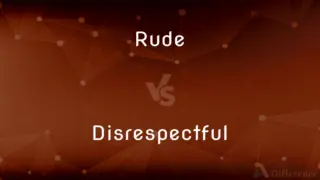Chainsaw vs. Jigsaw — What's the Difference?
By Tayyaba Rehman & Maham Liaqat — Updated on March 19, 2024
A chainsaw is a powerful tool for cutting through wood with a rotating chain, ideal for heavy-duty tasks like tree felling. A jigsaw is a versatile saw for detailed cutting, capable of creating curved lines in various materials.

Difference Between Chainsaw and Jigsaw
Table of Contents
ADVERTISEMENT
Key Differences
A chainsaw is primarily used in outdoor settings for tasks such as cutting down trees, trimming branches, and preparing firewood. It operates with a motor, either gas-powered or electric, that drives a chain with cutting teeth around a guide bar. This makes it highly effective for heavy-duty woodcutting tasks. In contrast, a jigsaw is a precision tool designed for detailed cutting work. It uses a reciprocating blade to make intricate cuts, including curves and patterns, in materials like wood, metal, and plastic. Jigsaws are commonly used in carpentry, construction, and crafting for their ability to make precise and artistic cuts.
The physical design and operation of these tools underscore their different applications. Chainsaws are built for power and durability, with larger, more robust bodies to handle the rigors of outdoor work. Jigsaws, however, are smaller, handheld tools that offer greater control for precision work. The versatility of a jigsaw also extends to the variety of blades available, which can be changed to suit different materials and types of cuts, whereas chainsaws use a singular type of chain that varies mainly in size and tooth design according to the cutting task.
Safety considerations for these tools are markedly different due to their operation and application environments. Chainsaws, with their high power and potential for kickback, require protective gear such as helmets, gloves, and safety glasses, along with proper training to use safely. Jigsaws, while also requiring safety precautions like eye protection, have a lower risk profile and are easier for beginners to handle with less extensive safety gear.
The choice between a chainsaw and a jigsaw depends on the nature of the task at hand. For large-scale, outdoor woodcutting tasks requiring power and speed, a chainsaw is the appropriate tool. For indoor or detailed cutting work requiring precision and the ability to navigate curves and intricate patterns, a jigsaw is more suitable.
Comparison Chart
Primary Use
Heavy-duty woodcutting (e.g., tree felling)
Detailed and curved cutting in various materials
ADVERTISEMENT
Operation
Motor-driven chain rotating around a guide bar
Reciprocating blade moving up and down
Ideal Environment
Outdoor, forestry, and landscaping
Indoor, carpentry, construction, and crafting
Blade/Chain Type
Chain with cutting teeth
Various blades for different materials and cuts
Power Source
Gas-powered or electric
Usually electric (corded or battery-powered)
Safety Risks
High (e.g., kickback)
Moderate (e.g., blade contact)
Required Safety Gear
Protective clothing, helmets, gloves
Safety glasses, sometimes gloves
Versatility
Limited to cutting thickness and material type
High, with different blades for precise cuts
Compare with Definitions
Chainsaw
Operates on gas or electricity for outdoor woodcutting.
He preferred a gas-powered chainsaw for its portability in the forest.
Jigsaw
Commonly electric, ideal for various materials.
Her electric jigsaw effortlessly cut through both wood and metal sheets.
Chainsaw
A powerful cutting tool with a rotating chain, used for tree felling.
The logger used a chainsaw to quickly cut down the large oak.
Jigsaw
A precision tool for making detailed cuts, including curves.
The carpenter used a jigsaw to cut intricate patterns into the plywood.
Chainsaw
Designed for rapid, straight cuts through thick wood.
With the chainsaw, they cleared the fallen tree blocking the road.
Jigsaw
Features interchangeable blades for versatility.
Switching to a fine-toothed blade, the jigsaw made a clean cut in the laminate.
Chainsaw
Requires specific safety gear due to high risks.
Before starting the chainsaw, he donned his protective helmet and gloves.
Jigsaw
Suited for artistic and precision cutting tasks.
Using a jigsaw, they created detailed decorations for the set design.
Chainsaw
Less versatile, mainly for woodcutting tasks.
Chainsaws are essential tools for arborists and loggers.
Jigsaw
Safer and easier for beginners to use.
The DIY enthusiast found the jigsaw straightforward and safe for his project.
Chainsaw
A chainsaw (or chain saw) is a portable gasoline-, electric-, or battery-powered saw that cuts with a set of teeth attached to a rotating chain driven along a guide bar. It is used in activities such as tree felling, limbing, bucking, pruning, cutting firebreaks in wildland fire suppression, and harvesting of firewood.
Jigsaw
A usually power-driven saw with a narrow vertical blade, used to cut sharp curves.
Chainsaw
A portable power saw with teeth linked to form a loop of chain.
Jigsaw
To cut or form with a jigsaw.
Chainsaw
A power saw that has a power-driven and fast-revolving chain of metal teeth, usually used to cut trees.
Jigsaw
To arrange intricately; interlock.
Chainsaw
To cut with a chainsaw.
Jigsaw
A power saw with fine teeth and a narrow blade which can cut curves in wood or metal.
Chainsaw
A portable power saw having teeth that are linked to form an endless chain, rotated about two pivot points by a power mechanism, such as an electric motor or a gasoline engine.
Jigsaw
A jigsaw puzzle.
Chainsaw
Portable power saw; teeth linked to form an endless chain
Jigsaw
Something that can be compared to a jigsaw puzzle.
Jigsaw
(transitive) To cut something using a jigsaw.
Jigsaw
A portable power saw with a reciprocating blade; can be used with a variety of blades depending on the application and kind of cut; generally have a plate that rides on the surface that is being cut
Jigsaw
Fine-toothed power saw with a narrow blade; used to cut curved outlines
Common Curiosities
Can I use a jigsaw to make straight cuts?
Yes, a jigsaw can make straight cuts, especially when using a guide, but it excels at curved and intricate cuts.
What safety gear is necessary when using a chainsaw?
Essential safety gear includes a helmet, protective clothing, gloves, and safety glasses to protect against kickback and debris.
Which tool is more suitable for a beginner?
A jigsaw is generally more suitable and safer for beginners, offering easier control and requiring less extensive safety gear.
Can a chainsaw be used for precision work?
Chainsaws are not designed for precision work; they are best for large-scale cutting tasks where precision is less critical.
What is the main difference between a chainsaw and a jigsaw?
The main difference lies in their use: chainsaws are for heavy-duty outdoor woodcutting, while jigsaws are for detailed, precision cutting in various materials.
How do I choose the right blade for my jigsaw?
The choice depends on the material you plan to cut and the type of cut desired; blades vary by tooth size, material, and design for different applications.
Can a jigsaw cut through thick tree branches?
While possible for small branches, jigsaws are not designed for thick tree branch cutting, a task better suited for chainsaws.
Is a chainsaw or jigsaw better for home DIY projects?
For most home DIY projects, especially those requiring detailed cuts or working with various materials, a jigsaw is more versatile and appropriate.
What are the environmental considerations for using a gas-powered chainsaw?
Gas-powered chainsaws emit fumes and require fuel, making them less environmentally friendly compared to electric models.
How do I maintain my jigsaw to ensure its longevity?
Regular maintenance includes cleaning, checking the blade condition, ensuring the motor and cord (if applicable) are in good shape, and following the manufacturer's guidelines.
Share Your Discovery

Previous Comparison
Rude vs. Disrespectful
Next Comparison
Policeman vs. SoldierAuthor Spotlight
Written by
Tayyaba RehmanTayyaba Rehman is a distinguished writer, currently serving as a primary contributor to askdifference.com. As a researcher in semantics and etymology, Tayyaba's passion for the complexity of languages and their distinctions has found a perfect home on the platform. Tayyaba delves into the intricacies of language, distinguishing between commonly confused words and phrases, thereby providing clarity for readers worldwide.
Co-written by
Maham Liaqat














































